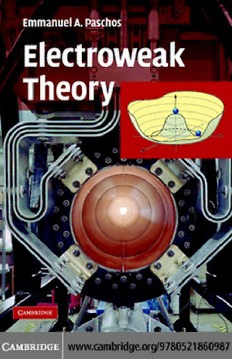
Electroweak theory PDF
Preview Electroweak theory
This page intentionally left blank ELECTROWEAK THEORY The electroweak theory unifies two basic forces of nature: the weak force and electromagnetism. This achievement is comparable to Maxwell’s unification of electricity and magnetism. The theory made numerous predictions that have been confirmed by experiments. This book is a concise introduction to the structure of theelectroweaktheoryanditsapplications. Electroweak Theory describes the structure and properties of field theories with globalandlocalsymmetries,leadingtotheconstructionofthestandardmodel.The greater part of the book explains the basic predictions of the theory. It describes the new particles and processes predicted by the theory, and compares them with experimentalresults.Amongthetopicscoveredareneutralcurrents,theproperties ofWandZbosons,thepropertiesofquarksandmesonscontainingheavyquarks, neutrinooscillations,CP-asymmetriesinK,D,andBmesondecays,andthesearch forHiggsparticles. Thebookcontainssectionsguidingthereaderthroughthecomplicatedcalculations of Feynman diagrams, such as box and penguin diagrams. There are discussions of the results and their relevance to physical phenomena. Each chapter contains selected problems, stemming from the long teaching experience of the author, to supplement the text. This will be of great interest to graduate students and researchers in elementary particle physics. Password protected solutions will be availabletolecturersatwww.cambridge.org/9780521880987. Emmanuel Paschos is Professor of Physics at the University of Dortmund, Germany.HeisaFellowoftheAmericanPhysicalSocietyandoftheInstitutefor AdvancedStudy,andacorrespondingmemberoftheAcademyofAthens. ELECTROWEAK THEORY E. A. PASCHOS UniversityofDortmund CAMBRIDGEUNIVERSITYPRESS Cambridge, New York, Melbourne, Madrid, Cape Town, Singapore, São Paulo Cambridge University Press The Edinburgh Building, Cambridge CB2 8RU, UK Published in the United States of America by Cambridge University Press, New York www.cambridge.org Information on this title: www.cambridge.org/9780521860987 ©E.Paschos2007 This publication is in copyright. Subject to statutory exception and to the provision of relevant collective licensing agreements, no reproduction of any part may take place without the written permission of Cambridge University Press. First published in print format 2007 ISBN-13 978-0-511-27156-4 eBook (Adobe Reader) ISBN-10 0-511-27156-5 eBook (Adobe Reader) ISBN-13 978-0-521-86098-7 hardback ISBN-10 0-521-86098-9 hardback Cambridge University Press has no responsibility for the persistence or accuracy of urls for external or third-party internet websites referred to in this publication, and does not guaranteethatanycontentonsuchwebsitesis,orwillremain,accurateorappropriate. TomywifeSharon andourchildren Anthony,Christina-Maria,andJohn Contents Preface pagexi PartI Theroadtounification 1 1 Theelectromagneticcurrentanditsproperties 3 1.1 Introduction 3 1.2 Thecurrentforhadronicstates 6 1.3 Parity-violatingformfactors 9 References 10 Selectbibliography 11 2 Theweakcurrents 12 2.1 Theweakcurrentsandsomeoftheirproperties 12 2.2 Thepartiallyconservedaxialcurrent 16 2.3 Regularitiesamongtheforces 18 ProblemsforChapters1and2 19 References 19 Selectbibliography 20 3 Thequarkmodel 21 3.1 Introduction 21 3.2 Currentalgebra 22 3.3 Quantumchromodynamics 26 ProblemsforChapter3 28 References 28 Selectbibliography 29 PartII Fieldtheorieswithglobalorlocalsymmetries 31 4 Yang–Millstheories 33 4.1 TheYang–Millsfield 33 4.2 Gaugeinvarianceinscalarelectrodynamics 36 vii viii Contents ProblemsforChapter4 39 Selectbibliography 40 5 Spontaneousbreakingofsymmetries 41 5.1 Spontaneousbreakingofglobalsymmetries:discretesymmetry 42 5.2 Continuousglobalsymmetries 44 5.3 Spontaneousbreakingoflocalsymmetries 49 ProblemsforChapter5 51 Selectbibliography 52 6 Constructionofthemodel 53 Selectbibliography 56 7 TheHiggsmechanismintheGlashow–Salam–Weinbergmodel 57 7.1 Massesforgaugebosons 57 7.2 Massesforleptons 61 ProblemsforChapter7 62 References 62 Selectbibliography 62 8 Theleptonicsector 64 8.1 Feynmanrules 64 8.2 Predictionsintheleptonicsector 68 8.3 Leptonicneutralcurrents 70 8.4 Weakeffectsinelectron–positronannihilation 76 ProblemforChapter8 77 9 Incorporatinghadrons 78 9.1 Themixingmatrix 78 9.2 Flavor-changingneutralcouplings(FCNCs) 82 9.3 Theelementsofthemixingmatrix 84 References 92 Selectbibliography 92 PartIII Experimentalconsequencesandcomparisons 93 10 Deepinelasticscattering 95 10.1 Kinematicsfordeepinelasticscattering 95 10.2 Hadronicstructurefunctions 99 10.3 Scalingandthetotalcrosssection 101 10.4 Thepartonmodel 104 10.5 TheDrell–Yanprocess 108 ProblemsforChapter10 110 References 111 11 Charged-currentreactions 112 11.1 Deepinelasticscattering 112 11.2 Evolutionofdistributionfunctions 117
